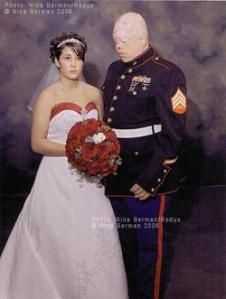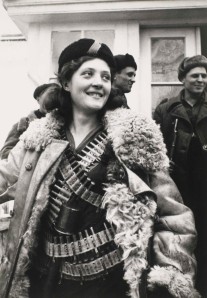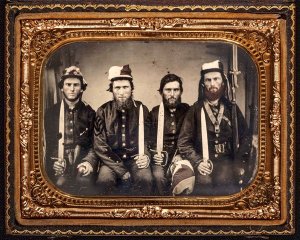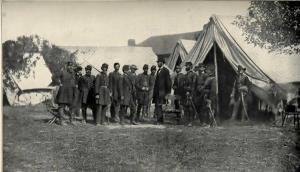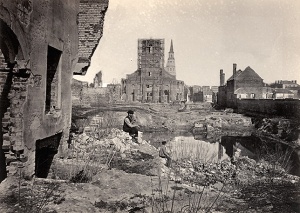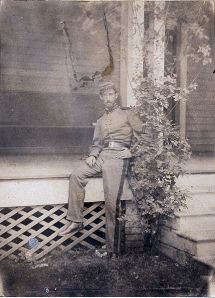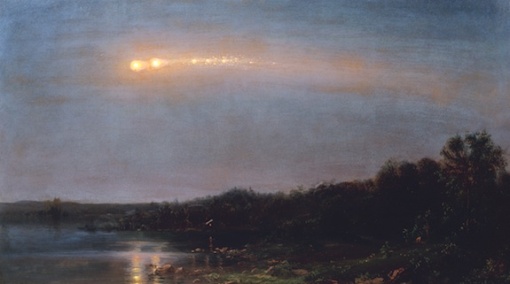Images of War in Brooklyn
Mankind has conceived history as a series of battles; hitherto it has considered
fighting as the main thing in life.—Chekhov, Notebook (1892-1904).
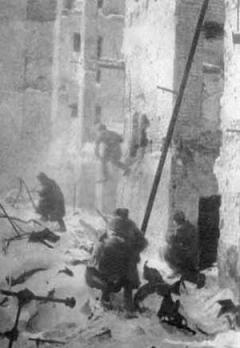
Captured Building, Stalingrad by Georgi Zelma (Gelatin silver print. 1942. Collection of William Broyles.) All the images here are in the exhibition.
The Brooklyn Museum of Art is currently exhibiting a massive show of war photographs called “War/Photography: Images of Armed Conflict and Its Aftermath.” The show was organized by the Museum of Fine Arts in Houston and has already travelled to the Annenberg Space for Photography in Los Angeles and the Corchoran Gallery of Art in Washitngton, D.C. The show runs through February 2 at the Brooklyn, which appears to be the last stop of the tour. So if you want to see it, you have to take the A Train (or the C or E or the 2 or 3) in the dead of winter. (My last trek to Eastern Parkway took place during heat so stifling that I would have welcomed the cold, windy, wetness that seeps into your soul as well as your soles. Well, it’s here.) Allot yourself several hours to view this installation, and be prepared for many images you have once seen, some surprises, many pictures that confirm things you suspected were true, some blatant propaganda, much that is plainly disturbing, but most of all, sensory overload.
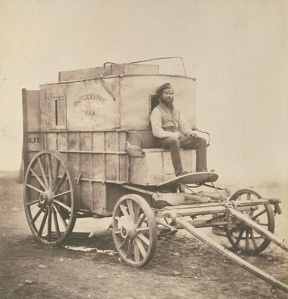
Roger Fenton’s Photographic Van (Salted paper print. ca. 1855. Royal Photographic Society Collection.) Fenton was sponsored and equipped by the British Government to document the Crimean War. That war was exceedingly unpopular among the public and Fenton, as a result, avoided scenes of death, which would shortly become a staple of independent war photojournalists.
The scope of the project is mind boggling. I counted 69 conflicts represented, from the Mexican-American War in 1846 to the Libyan civil war in 2012. Among the many violent conflicts that won’t immediately spring to mind as ones from which war photos can be seen are the Second Opium War (1856-60), the Moro Rebillion (1899-1913), the Sierra Leone Civil War (1991-2003), the Tuareg Rebellion (2007-09) and the South Ossetia War (2008). It seems that wherever there are groups intent on destroying other humans, there is the urge to document it visually. That urge is probably the most noble (although not sole) motivation of the great war journalists, and most of the ones who readily come to mind are represented here. From the very beginning of war photography (which coincided with the beginnings of modern total war) people like Alexander Gardner and Mathew Brady visited battlefields to bring the raw reality of carnage to an unsuspecting public. But also from the beginning some journalists and photographers, like Roger Fenton, were sponsored by the government to provide an official document of war or to shore up flagging popular support. Many of those are represented here as well. There are others with different motives: spies, souvenir-takers, relatives and profit-seekers. There is such a variety of images that throughout the exhibition, the question recurs, What was the motive behind this picture? And in a few cases: Was it really necessary for us to see this?
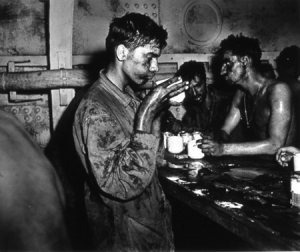
Coffee for the Exhausted Conquerers of Engebi Island–the United States Marine Corps by Ray R. Platnick, USCGR (Gelatin silver print. 1944. Museum of Fine Arts, Houston.)
There are nearly 500 photos exhibited, and all of them are, at a minimum, thought-provoking, many of them gut-wrenching. But the sheer size of the show makes it impossible to confer adequate reflection on more than a few items. And given the variety of subjects and sources of the photos a recurring question keeps surfacing: What were the organizers’ intentions? What are we supposed to get from these emotional images of grim events? Clearly, this is not a history of modern warfare. It is not organized chronologically (or in any other way that would allow for historical analysis), and it gives insufficient attention to aspects that would explain wars in historical terms (politics, economics, technology, and so forth). Plus photographs by themselves do not lend themselves to analysis; at best, they are only a piece of evidence.
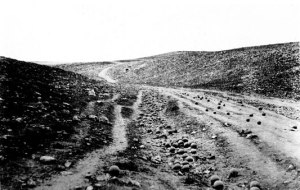
Valley of the Shadow of Death by Roger Fenton. (April 24, 1855. Salted paper print from negative. Museum of Modern Art, NYC.)
The exhibition does not portray itself as a retrospective or study of the techniques of photojournalism in war. There are more than 280 photographers (not all technically “journalists,” however), so necessarily there are too few examples from any particular photographer to get much of a sense of a body of work. Moreover, although there are some examples of camera equipment (from early boxes to the iPhone), not much is made of the technology of the photographs.
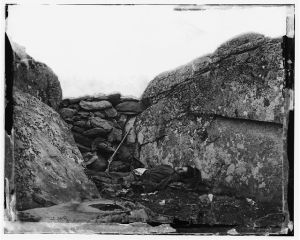
The Home of a Rebel Sharpshooter, Gettysburg, Pennsylvania by Alexander Gardner (1863. Albumen print. LoC.) Gardner moved the corpse into position to stage the composition.
You might, therefore, wonder (as I did): What is the purpose of assembling such an immense number of photographs of and about war since the invention of the camera? There is no overt ideology behind the organization, as far as I could tell. There is a selectional bias of course. The dramatic is selected over merely informative. And until relatively recently, only advanced technological societies had access to photography equipment and and a class of journalists dedicated to visual record-keeping. But the bias inherent in a photographic record aside, the overarching points made about war in the exhibit is mainly by organization. The show is arranged into a typology of sorts, each category representing a phase in how societies prepare for, fight, celebrate and remember war and how war impacts segments of society, both the conquerers and the losers. But as some of the later photographs show, even on the “winning” side there are large classes of losers.

Congolese women fleeing to Goma by Walter Astrada. (Chromogenic print. 2010. Museum of Fine Arts, Houston.)
The show’s categories include, for example, Recruitment, Training and Embarkation; Patrol and Troop Movement; Support; Refugees; Children, and so forth. Arranging the show in this way allows the organizers to go beyond traditional combat photojournalism, sometimes with striking results. One particularly effective image was taken by Kadir van Lohuizen in 2004 and entitled, “Diamond Matter, Democratic Republic of Congo.”* In it a diamond dealer wearing a vest and tie as well as a fashionable wide-brimmed fedora sits at a table with an electronic calculator, a scale and a few small rocks. He holds with a forceps a blood diamond for us to see. Behind him stands a slope-shouldered assistant. The wall is stenciled with “NO SMOKING!” and hold several pictures, including an open sacred text and a portrait of an open-armed Jesus. The portrait crystalizes why thousands are killed, mutilated and raped, and how a select few can hypocritically profit from wholesale butchery. Just as war against an entire people has become a late innovation to modern warfare, contemporary combat photojournalists put a faces on the new victims of total war. Walter Astrada is represented by a work from his series Violence Against Women in Congo, Rape as Weapon of War in DRC (taken in 2008), and such images are rightly considered images of war, although earlier photographers concentrated almost exclusively on the combatants.
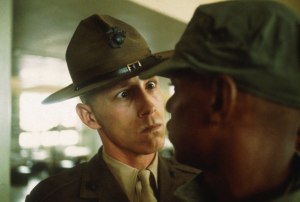
A US Marine Drill Sergeant Delivers a Severe Reprimand to a Recruit, Parris Island, South Carolina by Thomas Hoepkner (Inkjet print. 1970. Museum of Fine Arts, Houston.)
The manner of organization allows for the inclusion of a few marginally relevant photos, such as Mathew Brady’s Major Joseph Hooker. Yes, Hooker commanded the Army of the Potomac for a while and yes Brady was one of the founders of combat photojournalism. But what does a formal studio portrait add to this show other than simply another item? Fortunately, there are few of these missteps, and the broad definition of war photographs permits views of war that suggest how ability to fight full-scale modern war requires the harnessing of entire society. A photograph of an American transport plane with hundreds of troops in full combat gear holding weapons, jammed together like eggs in a carton, each one in his own fabric covered chair (not the benches of World War II or the Korean War) shows how we have come to master the commodification of troops and industrialized ourselves efficiently to begin combat anywhere. It is no wonder that we so often do. We no longer have many industrial factories, but we have created armed forces organized with the philosophy and brutality of any 19th century factory exploiting the proletariat. Thomas Heopkner’s photo of a drill sergeant at a Parris Island Marine Corps boot camp shows how training is a mixture of sadism and authoritarianism and how the sheer force of hierarchy permits someone who for all appearances would be a warehouse clerk outside the army to act the role of cock of the walk inside the militaristic cocoon.
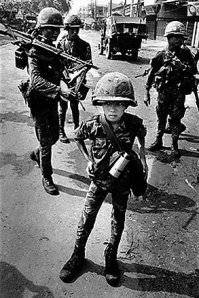
Called “Little Tiger” for killing
two “Vietcong women cadre” by Philip Jones Griffiths. (1968. Magnum Photos.)
When all these visual aspects are seen in turn, it’s hard to escape the conclusion that war is a central feature in our lives. And maybe the goal of the exhibition was to present the converse (obverse?) of Edward Steichen’s pahbreaking The Family of Man exhibition at the Museum of Modern Art in 1955. That show celebrated how we are all human, how all our joys are shared, and how much we have a stake in each other. The War/Photography exhibition also shows how alike we are, how war makes us all assume similar roles, how we react to trauma and grief and desolation the same. But war is a different teacher than the family of man. Children likewise can be trained, but in this exhibition they are not trained in the arts of play and music, but rather in the brutal art of hatred, blind loyalty and irrationality. A photo shows Russian children viewing the hanged bodies of other children executed as Nazi collaborators. Another shows a young Vietnamese “tiger” who killed two Vietcong (reputedly his mother and schoolteacher). And a third shows a disturbed young blond girl, drawing endless confused circles on a blackboard, describing Poland, her home. These and many other kinds of barbarities, repeated over and over, are eventually forgotten or explained away and life goes on, and memory only prompts us next time to inflict more destruction so that we do not suffer as much. If you go into this exhibition thinking war is “inhuman,” the images convince you that, quite the contrary, war is a quintessentially human activity, perhaps the quintessential human activity.
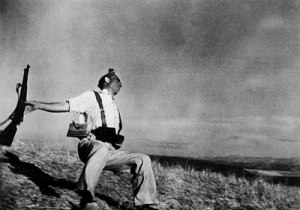
Death of a Loyalist Militiaman, Córdoba Front by Robert Capa. (Gelatin silver print. Late August-Early September 1936. Museum of Modern Art, NY.)
The photos in this collection of actual combat and the immediate aftermath have a dramatic urgency to them. They are startling because they all breath j’accuse. But since they don’t tell the complete story, it’s not usually evident who is to blame. Is it the enemy? Incompetent commanders? Our own government? Traitors? We sympathize so completely with the victims that it is dangerous for the accused to be confronted with such powerful evidence. And often the response is to claim that the evidence is faked. And there is enough instances of it, to make the claim colorable. Gardner moved the corps in his Sharpshooter (above left) to make the composition more dramatic. Fenton’s picture of the Crimean field that had been extensively shelled (above right) is followed by another taken shortly thereafter with the cannonballs moved. John Filo (or his editors at Life) removed the fencepost above Mary Ann Vecchio’s head in the photo of her kneeling over the body of Jeffrey Miller at Kent State when it was first published (see here). These liberties did not change the facts (the sharpshooter was in fact dead in Devil’s Den, as was Miller at the hands of the National Guard; the Ukranian field had been extensively shelled in 1855), it softens the accusation to make the debate about the photo rather than the underlying facts. When Robert Capa misremembered where he took the photo of the Republican soldier falling from a Falangist bullet, claims of staging were made (and continue), because otherwise it equates the Loyalist with the patriot in Goya’s famous Third Day of May 1808. Such an identification would undermine the myth that Franco represented the “real” Spain, and instead put him in the position of the foreign forces of Napoleon who imposed their will on Spain. Governments who rely on the military for authority cannot afford to have any doubt about their legitimacy.
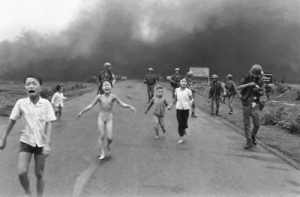
Fleeing down a road near Trang Bang after a South Vietnamese Air Force napalm attack by Nick Ut. (June 8, 1972. Associated Press.)
The US government would find how its authority could be eroded most dramatically during the Vietnam War. Having enjoyed immensely favorable war coverage during the Second World War (the show is filled with journalists who identified with the mission and even photographers sponsored by the government; there is even a series of photos showing the different flag raisings on Iwo Jima, taken until the iconic photo was eventually framed), the military in Vietnam was completely unprepared for the photojournalists who would report from there. It is difficult to think of any group of reporters, on the whole, who so extensively documented a conflict, with such independence, thoroughness and courage as the ones who photographed that tragedy. Taking advantage of unrestricted access to the troops and battlefields and hospitals, they made a scathing record of Americans actions there. Their valor and integrity made that record as impeccable as it was self-evident. So when the incessant images from that war all pointed in the same direction—that there was no strategy, that our client had no real popular support, that our foes were willing to die longer than we were willing to kill, and that, most crucially, our policies were in fact destroying the very people we claimed to be protecting, and doing so in spectacular, immoral and insidious ways—our government’s insipid pleas that progress was being made were simply not credible. Loss of public support for a costly foreign misadventure was serious enough, but there would be much more to concern those who ran our war-making apparatus. Years of pictures of Buddhist monks immolating themselves, police chiefs shooting prisoners point blank, thousands of acres of forests burning, innumerable bombs dropping, hideous wounds in god-forsaken places, and shockingly in 1968 close-range fighting in urban areas including at the very door of the US Embassy all conspired to disabuse the American public of their belief in the competence and integrity of our National Security Machine. Then in 1972 we saw Nick Ut’s stunning photo of the naked girl running from the napalm attack on her village. There was now widespread consensus that we, our allies and our mission were evil. This threatened to make warfare as a usual method of policy untenable in the future.
War photography was not the only reason that it took policy makers nearly two decades to coax the public back to war as politics. But the Neo-Cons who most ardently desired to flex military muscle to achieve policy goals thought long and hard about restricting visual records of our war mongering. They would never again allow a news corps like the one that covered Vietnam to influence the public again. So a combination of policies, including co-opting the press, was put in place when we eventually returned to the role of corrupt policemen. Although our invasions of Iraq and Afghanistan covered many more years than did our involvement in Vietnam, they did not produce a comparable visual account as intimate and detailed and objective and honest. Real combat photojournalism seems relegated to conflicts in those parts of the developing world in which our leaders have no interest. But this is not to say that contemporary photojournalists are entirely unable to produce images that convey some of the realities of wars we participate in. Often, however, that involves composed photographs, some of which, nevertheless, have considerable power. Nina Berman’s work with disabled veterans on return home, produced an extraordinarily expressive and disturbing image, entitled Marine Wdding. The impact is especially powerful given how large the print shown was. The photograph is simply a wedding picture of a marine and the school girlfriend who waited for him to return from duty. He is dressed in a Marine Dress Uniform, but his face and skull is severely disfigured. (His skull had been crushed and his flesh severely burned while trapped inside a truck after a suicide attack. His ears, nose and chin were missing.) He looks tenderly at his bride from above. She does not look at him, but rather stares straight out with an expression that betrays emotions other than pure joy. They both, in their own ways, show their attachment to selfless Duty: he had already received his reward for it, she was about to.
As for photographic insight into the wars now fought in our name, and especially those that set up a narrative in opposition to the official one, they now largely, and ironically, come from our own soldiers. The photographs that exposed the crimes at Abu Ghraib are one example. The July 12, 200y, air assault by two AH-64 Apache helicopters in Baghdad, published by Wikileaks as Collateral Murder is another. The desire to document war and especially one’s role in it must be extremely seductive. It probably has to do with the belief that Chekhov wrote of: that warfare is thought of as the main thing in life. From the soldiers who posed for portraits by Mathew Brady before heading off to extreme risk to the Japanese pilot who recorded the attack on Pearl Harbor, there must be a near universal belief that participating in war is the most important thing one will ever do and that it is well worth recording one’s role in it. It is visual proof that one was significant.
Photographs, as I said, are not history. They require analysis and must be placed in context. And despite their power, they are selective. Wars are not caused solely by attacks, despite the images of the World Trade Center, the USS Maine or a rally at the Nürenberg Stadium (all in the “Advent of War” section of the show). But politicians are careful not to photograph themselves concocting attacks in the Gulf of Tonkin or fabricating evidence of weapons of mass destruction. War photographs, like any other museum quality souvenir, are suggestive, and in this case, there are enough good souvenirs to provoke considerable thought for quite a while.
* * *
For those unable to make this exhibition or who would otherwise like a more permanent copy of the images, there is a large, hard cover, 600+ page catalog produced by Anne Wilkes Tucker and other organizers from the Museum of Fine Arts, Houston. † The reproductions are excellent, and the book provides extensive commentary and historical context not provided in the exhibition.
Notes
*The particular image appears to be an untitled photograph which is part of a series by that name. The NOOR Foundation asserts copyright protection for the image, so I don’t reproduce it here. You may, however, see a black and white version of it at the NOOR Foundation website here. [Return to text.]
†Anne Wilkes Tucker, Will Michels, Natalie Zelt, et al.,War/Photography: Images of Armed Conflict and Its Aftermath (2012: Museum of Fine Arts, Houston). [Return to text.]
